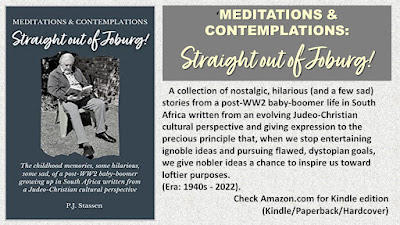All Rights Reserved
▊SOTHO
PEOPLE. Sotho people are described briefly as follows: “Sotho,
also called Suthu or Suto, linguistic and cultural
group of peoples occupying the high grasslands of southern Africa. The main
groups are customarily classified as the Transvaal, or northern, Sotho (Pedi, Lovedu, and others); the
western Sotho, or Tswana (q.v.);
and the southern Sotho (often called Basuto) of Lesotho and adjoining
areas.” [Britannica.com].
▊BASOTHO QWAQWA (WITSIESHOEK). “Qwaqwa, also called Basotho
Qwaqwa, formerly Witsieshoek, former nonindependent Bantustan, Orange Free State, South Afri-ca, designated for
the southern Sotho (often
called Basuto) people. Located in a section of the Drakensberg, Qwaqwa was a
glen among mountains at elevations from 5,500 feet to more than 10,000 feet
(1,675 m to more than 3,050 m). It was a headwaters area for several streams,
including the upper Elands, an important source of water for the Vaal Dam
complex.” [Britannica.com/place/qwaqwa].
▊GROWING UP. Now, before I come to the story about my erstwhile friend ‘Piet’ from Witsieshoek, I first must sketch my background in order for the picture to be clear. Before my father had opened his string of small ‘general dealer’ shops in our district, I’ve been growing up in Randgate on Johannesburg’s ‘West Rand’ as the son of a ‘goldminer’ and on one of the richest gold reefs of South Africa, if not indeed in the world.
My father’s designation at the ‘Randfontein Estates Goldmining Co.’ was that of a ‘shaft carpenter’, and, at the time of the ‘incident’ that later involved some of my dear friends, we’ve been living in the bustling mining town of Carletonville in a stereotyped (but decent) company ‘bungalo’ in Kaolin Street and where my father, at that time, was working at the ‘West Driefontein Goldmining Co.’, the same mine where I later, in 1967, started working as 'a 'tracer' after leaving school and after having finished my year of compulsory military conscription in 1966.
▊ENTERS ‘PIET’
FROM WITSIESHOEK. I was in Standard 5 (now Grade 7) when my mother had, a few months earlier, given a temporary job to a migrant (domestic) worker from Witsieshoek in Lesotho who had a son of my age with whom I shared a name and with whom I had been playing in our yard after school, e.g. boxing, wrestling and some boyish ‘African stick-fighting’ or ‘sword-fighting’, with some makeshift swords made from our (by then) threadbare little blue ‘hula hoops’, so in vogue in 1958 thanks to champion swimmer Esther Williams and Hollywood movies.
Bear in mind that, at the time, I also had two brothers, years younger than I, and whom I (as the eldest) did not consider of much ‘utility value’ except for being an annoying nuisance on Saturday mornings when I tried to sleep late; the upshot of that childish snobbery was that ‘Piet’ from Witsieshoek and I became inseparable buddies, spending many a summer afternoon boxing, wrestling and ‘sword-fighting’ on the lawn in our front yard. Years later my mother, at, for instance, Christmas time, would recall how she, much amused, used to watch us from behind lace curtains in the lounge as we were boxing, wrestling and rolling in the grass in our mortal struggles for survival at all costs.
The plot, however, was to thicken and thicken badly, and never did I realise that, at that moment, I was being physically prepared, and my sedentary muscles being honed, for the most epic of battles in my boring and rather uneventful little suburban life.
▊THE AMBUSH. It was in 1959 and I was going on 12 when, while we were having dinner one evening (I remember the scrambled eggs-on-toast so vividly), two of my neighbourhood friends, Wayne and Bill (aliases), came up to our house to proposition my father for me to go with them and play on an empty plot at the back of our house; my father acquiesced and, within minutes. I jumped the wooden ‘splitpoles’ fence that gave access to the empty plot of land and where my two pals were already waiting for me, installed menacingly on top of a heap of derelict, weed-infested building gravel.
Like the proverbial lamb to the slaughter, I had no idea what kind of ‘design’ they had in mind, but since we had earlier been involved in all kinds of Tom Sawyer type mischief, i.e., like catching little silver lizards and colourful brown geckos with our bare hands and stocking my mother’s storeroom in the backyard with all kinds of horrid reptiles or, trying to make ‘wine’ from surplus grapes from Wayne’s father’s vineyard (it didn’t work).
▊THE OPENING
VOLLEYS. So, without any prior warning, and for no (known) reason whatsoever, they jumped me and started beating me up. I was, however, so shocked and outraged by this unprovoked treachery that I, within a matter of seconds, turned into a frenzied dynamo of energy probably sparked by the adrenalin rush from the fight-or-flight impulse.
I was doing reasonably well well due to our months of preparatory, Spartanlike gladiatorial activity when welcome help suddenly parachuted in from an unexpected quarter; through my tears and the barrage of blows and kicks I looked up only to see my skinny, brown little Sotho pal jump that fence like the proverbial ‘bat out of h…ll’ and boy, did we give my two ’assailants’ a thorough thrashing.
▊CONCLUSION. Now, the Bible rarely if ever mentions the skin-tone of the various folks involved in the entire Biblical narrative from Genesis to Revelation, though ‘race by nationality’ (e.g., ‘Ethiopian’, Egyptian, Hebrew etc.) is often implied. When the chips are down, however, I have found that we are all the same of only two possible ‘colours’, i.e., on the side of either DECENT and KIND vs. UNDECENT* and UNKIND which has nothing to do with the colour of our skin or the language we speak, but everything with our humanity (or lack of it).
*Not to be confused with 'indecent'.
✋



No comments:
Post a Comment